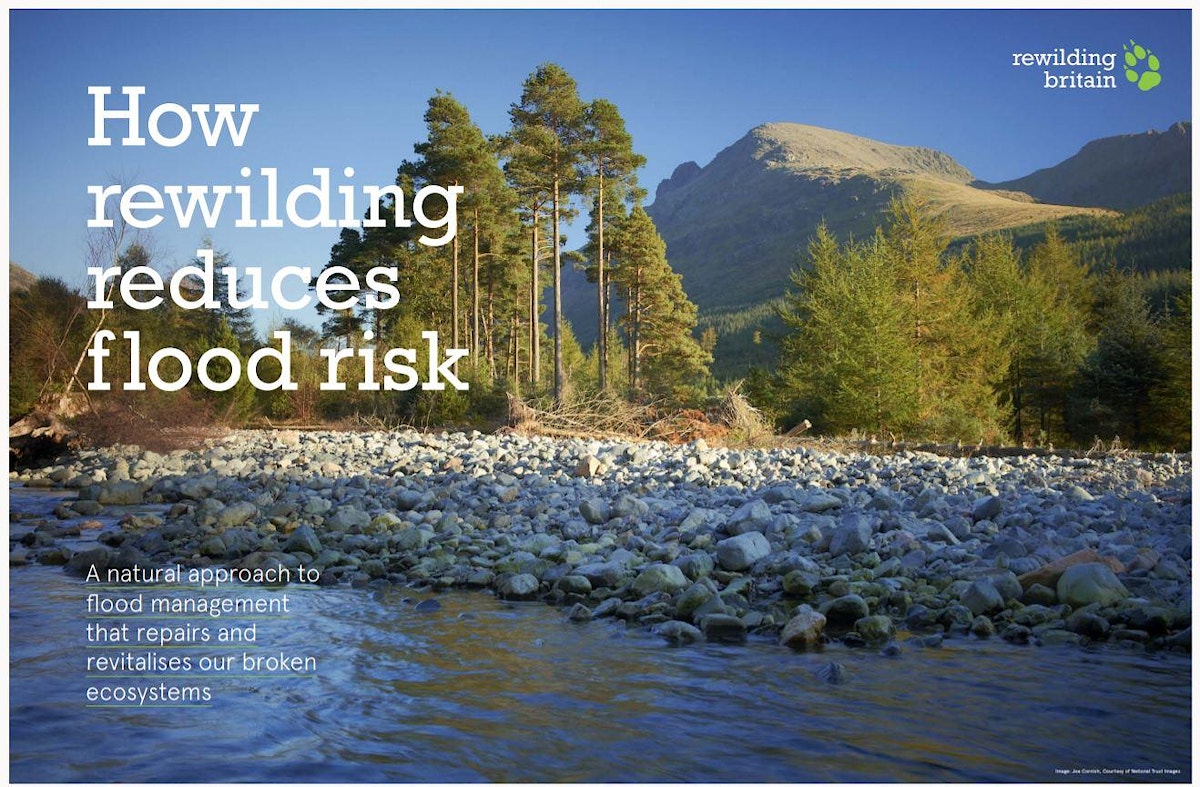Rewilding and flood risk management

£1.1
billion annually spent on flooding costs
As our climate changes, we are increasingly experiencing the impacts of flooding here in Britain.
Communities all around the country are dealing with floods at a huge cost to individuals, businesses and the economy – flooding costs the UK economy £1.1 billion annually on average, and the 2015 disastrous floods may have cost as much as £5 billion [1].
More frequent heavy rainfall is one of the factors that have increased flood risk. Another major influence is the way in which land is managed. We believe that the restoration of some of our damaged ecosystems could play a major role in the prevention and mitigation of the kind of floods now blighting communities across the UK.
The role of rewilding in reducing flood risk
Rewilding is an approach to land management that seeks to work with natural processes to restore ecosystems and reconnect society with the natural world. We believe rewilding has a crucial role to play in our efforts to reduce flood risk and adapt to the impacts of climate change. Rewilding projects are long-lasting, involve communities in decision-making and improve the area for wildlife as well as people.
There are a range of rewilding practices that can help prevent freshwater flooding. There is increasing evidence and support for such approaches, but it is clear that “it will need political leadership from the highest level to make it happen” (Katherine Pygott, Chartered Institution of Water and Environmental Management) [2].
Here we focus on three key ways in which rewilding can reduce flood risk at the same time as ensuring ecosystems are restored: through good land management practices; restoration of our rivers; and reintroducing beavers. We will be producing further briefings on how natural flood management can help reduce surface water flooding (e.g. through Sustainable Urban Drainage systems in cities) and coastal flooding (e.g. through salt marsh restoration).
Land management practices
Every parcel of land in a catchment, including that within urban areas, can make a contribution to reducing the probability of flooding, with the uplands and floodplains playing vital roles in slowing the flow of water and providing enhanced water storage at a landscape scale. There are a range of practices that can help reduce flood risk, including the creation and restoration of wetlands, peatland restoration (including blocking of moorland drainage ditches), and changes to farming practices (including low tillage and reduced stocking densities) to reduce soil erosion and compaction.
Tree planting and natural regeneration of trees and scrub, in particular, can significantly reduce flooding, soil erosion and water pollution [3]. Studies of the Pontbren Project in mid-Wales, where shelter belts of trees were planted across sheep pastures, discovered that water infiltrates into the soil under the trees up to 60 times the rate at which it infiltrates into the soil under the pasture [4]. The tree roots appear to create channels down which the water can flow, allowing the soil to function as a sponge. By contrast, heavy grazing, as a result of the removal of deep vegetation and compaction of the soil by the feet of livestock, ensures that the land is much less permeable.
One research paper estimates that reforesting just 5% of the upland landscape reduces flood peaks by around 29%, while full reforestation would reduce them by some 50% [5].
A study for the National Trust concluded that at a small catchment scale (less than 100 km²) – which applies to 97% of England and Wales – land management has a quantitative impact upon run-off and can be used as part of an integrated approach to flood risk management [6]. The Pitt Review recommended that the UK’s key agencies did more to manage flood risk through working with natural processes [7]. Defra invested in three trial flood management demonstration projects in 2009 which aimed to work with nature to prevent flooding. One of these studies on the Holnicote Estate in Exmoor has demonstrated a reduction in downstream flood risk and a wide range of other benefits. Five years after the scheme was introduced there has been no flooding in villages that had regularly flooded in the past, even during the severely wet winter of 2013 – 14.
A set of newly constructed, offline, bunded flood storage areas helped to deliver a 10% reduction in flood peak during a severe storm in late December 2013 on an already saturated catchment [8]. The project has also changed public perceptions, winning increased support from local communities [9].
Despite the growing evidence to support the role of ecosystem restoration in flood risk management, there is still a lack of action on the ground, and a number of key policy barriers need to be addressed [10.1, 10.2]. For example, the basic payment to farmers under Pillar One of the Common Agricultural Policy (CAP) includes a rule that they must keep the land bare by not allowing any “Permanent Ineligible Features” (PIFs). The Government’s list of proscribed PIFs includes woods, dense scrubs, wide hedges and ponds — all features that could help slow the flow of water through landscapes and mitigate floods [11]. It’s clear that the Permanent Ineligible Features rule needs to be removed.
Another practice that can contribute to increased flood risk downstream is the burning and draining of upland peat. Intact peat helps to retain water upland for longer and is a major carbon sink.
Blocking ditches and drains on peat bogs has been shown to help slow flows and raise water tables [12]. We need to see more incentives for landowners to restore peatlands in order to help with flood prevention.
River restoration

The management of rivers can have a major impact on the speed and severity of flooding. During the 2014 Somerset floods, there was much discussion about the utility of dredging to prevent floods. But often dredging is uneconomic, damages rivers, and produces only minor and temporary effects on river flows. What’s more, where dredging does actually speed up the flow of rivers, this can simply create more flooding problems further downstream. A better, longer-term solution to rivers filling with sediment is to address why so much soil is flowing into our rivers in the first place – and that means more soil conservation upstream [13].
During the devastating floods in Cumbria in 2009, river managers noted a massive difference in the response of the St John’s Beck in Thirlmere, which had been canalised and straightened, and the River Liza in Ennerdale, which had been allowed to rewild: to braid and meander naturally, to form islands and accumulate banks of stone and woody debris. The St John’s Beck suffered a massive pulse of floodwater, roaring down the river valley. The River Liza was still clear and fordable the day after the downpour had occurred. The obstructions in the river slowed and filtered the water, protecting settlements downstream from flooding. Downstream from Ennerdale, neither Ennerdale Bridge nor Egremont (or other smaller villages) flooded on at least two occasions in the last six years (including recent events in 2015) when torrential rain fell on the Western Lake District.
But towns and villages on the western edge of the Lake District with rivers flowing down adjacent valleys, and subject to ‘traditional’ management and land use, flooded terribly, and have done so more than once. They include Cockermouth, Workington and several other smaller villages [14].
Dredging, canalisation and embankment speed the flow of water downstream, while ecological restoration turns out to be as good for people as it is for wildlife. In other experiments, ‘leaky dams’ have been deliberately placed in rivers — made out of wood, straw bales and brash (felled trees) — helping to slow the flow of water without entirely blocking up watercourses [15]. For example, at Pickering, the Slowing the Flow Partnership installed 167 ‘leaky’ woody dams and 187 heather bale dams within streams, helping to slow the flow of water downstream and reducing their propensity to flood [16]. What’s more, these measures cost a fraction of the hard flood defences originally proposed for the area. Of course, it would be even better if there was a way to allow nature to do this work for free. Fortunately, there is.
Beaver reintroduction

One low-cost solution to reducing flooding is to allow beavers to return to our rivers. The dams they build and the woody debris they place in watercourses can have a powerful influence in slowing the flow. Following the reintroduction of beavers to Belgium, one study found a significant lowering of peak flow downstream of dams and an increase in the interval between major floods [17]. In one North American study, water took 3 – 4 hours to travel 2.6km where there were no beaver dams. When a single, leaky beaver dam, 1.5m high, was established, it took 11 days to travel the same distance [18]. Natural England commissioned an extensive study in 2009 on the feasibility of reintroducing beavers to Britain [19]. Overall the authors found that beavers regulate river flows and beneficially reduce flood peak levels downstream, stating: “The overall result of beaver construction is an increase in both aquatic and riparian habitat diversity and an increase in channel stability.”
Results from a University of Exeter study of a new colony of beavers in Devon show that as well as their dams helping to regulate water flow, their presence can cleanse water and boost fish populations at the same time [20].
The Natural England feasibility study found that despite mixed views from stakeholders, there was good support for beaver reintroduction [21]. Some landowners fear that beavers can harm their crops and increase flood risk while angling organisations have suggested these structures will impede the movement of migratory game fish. Beavers can cause problems – but in Bavaria (where beavers were reintroduced in 1966) it has been found that 98% of these are within 20m of watercourses.
The majority of problems are easily resolved by two part-time beaver managers, employed by the state, who coordinate a wider network of trained “beaver volunteers” who remove dams, fit beaverproofing to trees, drain dams, trap and translocate or cull beavers where there is no other option.
The state managers have derogated powers to issue licences to the volunteers to resolve beaver management issues swiftly. This Bavarian example, which has been widely emulated in other European countries such as Austria and Switzerland, demonstrates that it is possible to put in place a practical system of beaver management which enjoys the confidence and support of the majority of those involved.
Whilst beavers will not help in every catchment, as part of a package of measures on smaller scale catchments they could be a cost-effective part of flood prevention. The habitats they create improve carbon sequestration, contributing to the alleviation of climate change as well as its impacts [22].
With a good education programme and an understanding from emerging evidence of the multiple benefits of beavers, a programme of reintroduction seems timely. The reintroduction of beavers across Britain is both possible and desirable — further licenced releases should be permitted to restore this keystone species.
Working with communities

We believe flood-prone communities should have a lead role in catchment management. Community planning processes should be established which enable communities to negotiate with landowners upstream and to determine how flood management budgets should best be allocated. They should be supported by professional facilitators, expert advice, public money and official empowerment.
A pioneering scheme in Belford, Northumberland is a good example of how this can work. The Environment Agency worked with the community across a catchment to manage run-off and slow the flow of the river through a range of mechanisms, including barriers to slow river flows and the creation of storage ponds. A bonus is that it was relatively low-cost, at £300,000 compared to a conventional scheme estimate of £4million. The project was so successful that it is being rolled out in other parts of Northumberland [23].
Another good example of a strong partnership approach is in Yorkshire where a more sustainable approach to managing flood risk has reduced the risk of flooding in Pickering from a 25% chance in any year to a less than 4% chance [24].
It is clear that projects which involve people across a whole catchment in exploring options for flood prevention in their area are the best way forward. We need to see a faster rollout of projects like these at scale.
Recommendations
- Remove policy barriers to natural flood risk management such as the designation of trees, scrub, ponds and wetlands as “Permanent Ineligible Features” for farm payments.
- Government should push for reform of the CAP to incentivise ecosystem restoration.
- Incentivise afforestation, particularly in upland areas, through Countryside Stewardship, voluntary initiatives and novel funding approaches.
- Government should produce a strategy to ensure that we protect and secure multiple benefits from carbon-rich soils and peatlands, and end unsustainable use of peat.
- Ensure that the relevant agencies’ delivery staff have access to information about successful case studies which have alleviated floods through working with natural processes.
- Natural England’s Board should confirm a position statement that supports licensed reintroduction of beavers as part of flood and water national objectives.
- Ensure that catchment bodies responsible for new flood schemes consider the role that beavers can play in their area.
- Give flood-prone communities a lead role in catchment management by developing community planning processes which enable these communities to negotiate with landowners upstream and to determine how flood management budgets should best be allocated. They should be supported by professional facilitators, expert advice, public money and official empowerment.

Read our report on how rewilding reduces flood risk
Download pdfABOUT US
Rewilding Britain
Rewilding Britain is a charity set up by people with a passion for nature. We want to see the mass restoration of ecosystems in Britain, on land and at sea. Rewilding can reverse centuries of ecological damage. We can re-establish natural processes, reconnect with nature and regain wonder for the natural world. We want to inspire, inform and build a wider movement for rewilding.
We seek to collaborate with and support local groups and other organisations, some of whom are already working to rewild land and sea. www.rewildingbritain.org.uk
Friends of the Earth Limited
For more than 40 years we’ve seen that the wellbeing of people and planet go hand in hand – and it’s been the inspiration for our campaigns. Together with thousands of people like you we’ve secured safer food and water, defended wildlife and natural habitats, championed the move to clean energy and acted to keep our climate stable. www.foe.co.uk
[1] Flood defence spending in England, House of Commons Briefing, Nov 2014.
[2] Back-to-nature flood schemes need 'government leadership', BBC News article, January 2014.
[3] The Role of Productive Woodlands in Water Management, Confor and Forest Research, March 2015.
[5] Impacts of Upland Land Management on Flood Risk, FRMRC, December 2008.
[6] Land Management and Flood Risk Evidence for the Pitt Review, the National Trust, March 2008 (link unavailable).
[9] Flooding in Focus: Recommendations for more effective flood management in England, RSPB, 2014 (link unavailable).
[10.1] An appraisal of current evidence from the Defra-funded Multi-Objective Demonstration projects, February 2016.
[10.2] Working with Natural Processes to reduce flood risks. Environment Agency, Defra, Natural Resources Wales, July 2014.
[11] The Basic Payment Scheme England 2015. Rural Payments Agency, February 2016.
[12] Multiple benefits of river and wetland restoration. Alastair Driver, January 2016.
[13] The geomorphic effects of river dredging. The River Management, March 2013.
[14] Presentation by Sir John Lawton to the National NIA event, Coin St conference centre, 23rd February 2016 (link unavailable).
[15] Killer facts and benefits of river and wetland restoration, NERC-CBESS (link unavailable).
[16] Slowing the Flow at Pickering, various reports, Forest Research.
[18] The Beaver: Natural History of a Wetlands Engineer, Müller-Schwarze, D., and L. Sun. 2003.
[20] Exeter University have not yet published their findings but some data can be found in the document at note 12. Also, see the following article: “Should the UK bring back beavers to help manage floods?” New Scientist, November 2015.
[22] Beavers have been busy sequestering carbon, New Scientist, July 2013.



